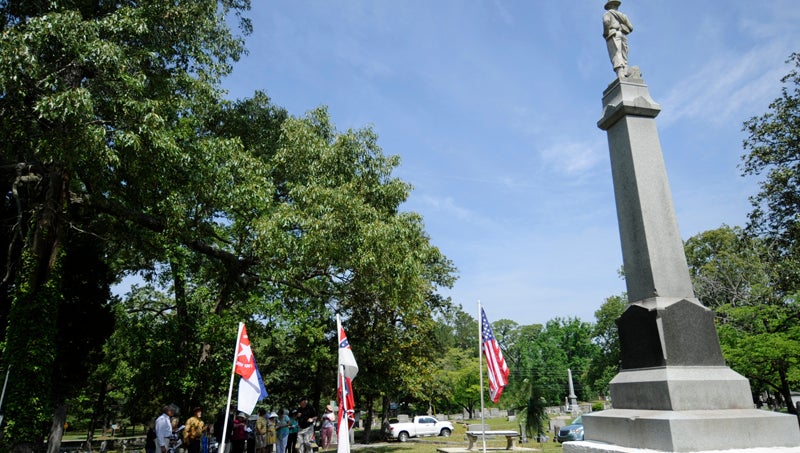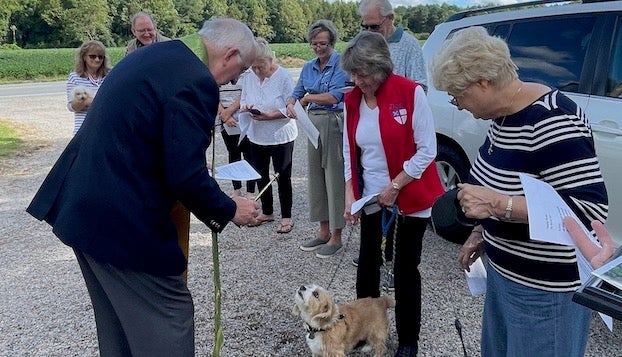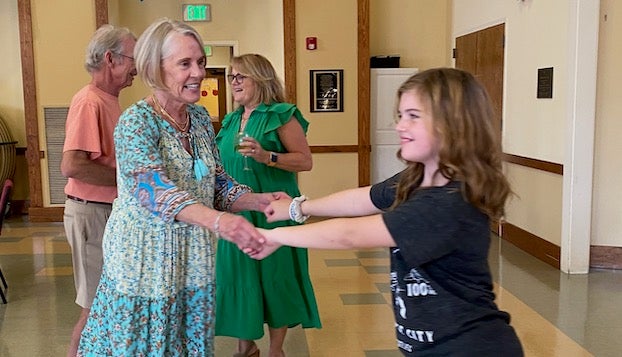A look at the history of Washington’s Confederate monuments
Published 7:41 pm Friday, October 20, 2017
The private soldier
He stands at rest atop a granite pedestal on the grassy crest of a small mound in Oakdale Cemetery overlooking the remains of his Confederate comrades killed in the Civil War, rifle at his side and gazing eternally into the westward horizon. Below and to his right is a solitary black Civil War cannon barrel pointing defiantly northward.
Mounted and unveiled on May 10, 1898 (Confederate Memorial Day), the statue was modeled after Capt. Thomas M. Allen, Co. E, (Southern Guards), 4th North Carolina Infantry. Allen was captured at Gettysburg and with 600 other prisoners of war confined at Morris Island, South Carolina, during the siege of Charleston.
Ten years earlier, on May 10, 1888, Beaufort County became the first in North Carolina to erect a monument honoring rebel soldiers killed in the war. The monument, without the statue, was originally placed on an elevation at the intersection of Water and Monumental streets (now MacNair Street). The location was chosen so that the monument would be the first thing seen by ships coming up the Pamlico River. When a new railroad station was built, changing the character of the location, the town decided to move the monument to its present location in the cemetery.
It was then decided to adorn the monument with a statue. The formal unveiling on May 10, 1898, was honored with a grand procession and dedication ceremony organized by the Ladies Memorial Association of Beaufort County with assistance from the Washington Greys, an auxiliary of the association composed of local children and youth. The Greys had been organized by Washington resident Mrs. W.H. Call in 1897 and originally consisted of 88 children.
The Ladies Memorial Association of Beaufort County was one of many in North Carolina. Associations had formed throughout the state in the late 1800s to assist the all-male Ex-Confederate Association in assuring that “history should do full justice to the part borne by the sons of North Carolina in the gigantic struggle; and that the memory of those who fell in her defense should be cherished.”
The Beaufort County chapter was organized Sept. 3, 1883, by a number of ladies in Washington who gathered at the county courthouse in response to a call from Maj. Thomas Sparrow, founder of the county’s Ex-Confederate Association. According to Mrs. J.B. Grimes, wife of Confederate Maj. Gen. Bryan Grimes and president of the Pamlico Chapter of the Daughters of the Confederacy in 1898, the Ladies Association was formed to assist the Ex-Confederates in telling the story of their wartime experiences and preserving their graves and memories.
In addition to the Greys, the Ladies Memorial Association was assisted in the unveiling of the Private Soldier Monument in 1898 by the Pamlico Chapter of the United Daughters of the Confederacy. According to the official program prepared for the event, the day began with decoration of the graves, followed by a procession from the Town Hall to the monument. The chief marshal was Col. Frank M. Parker of Enfield. The march included the Washington Coronet Band, former soldiers marching with their units, the Ladies Memorial Association and the United Daughters of the Confederacy, the Washington Greys, public school children and citizens. Col. Julian Shakespeare Carr of Durham, “a courtly and gallant gentleman,” delivered the address. Orations were given by Mary Kathleen Bogart “To the Private Soldier” and by Annie T. Bragaw “To the Lost Cause.”
The defenders’ monument
A related mission of the Beaufort County Ladies Memorial Association was “to gather the sacred dust of Confederate soldiers sleeping in the bosom of old Beaufort and place them side by side within the sacred precincts of the cemetery o’ershadowed by a suitable monument, erected in their memory,” according to The Confederate Reveille, Memorial Edition. The Reveille was a historical and memorial magazine prepared and published by the Pamlico Chapter of the United Daughters of the Confederacy under the leadership of its president, Mrs. J.B. Grimes.
To that end, the remains of rebel soldiers scattered throughout the county were gathered and reinterned in Oakdale Cemetery. A second Civil War monument honoring the reinterned was placed to the west of the Private Soldier and dedicated on May 19, 1905. It was named the Beaufort County Defenders’ Monument and dedicated to “the memory of 17 soldiers killed in the defense of Washington, 1862” who, it was later written, were found “sleeping at case, beneath the straggling boughs of an old storm-swept tree, just as the foe had placed them, side by side, in the same trench, heads and feet together, and one poor fellow lying face downward.” Seventeen Civil War cannonballs were set atop the monument. The cannonballs had been gathered by the Greys from those actually fired by Union forces during the bombardment of Washington in 1862.
The Pamlico Chapter of the United Daughters was the second chapter chartered in North Carolina. Members were committed to the proposition that the history of the Confederacy be honored in “all its integrity.” To that end, histories that were thought to deal unfairly with the Confederacy were in some states abolished. In 1987, the Daughters of North Carolina passed a resolution arguing that “the school histories of the United States now in use in our Southern schools, coming from Northern authors and Northern publishing houses, do not properly set forth many matters pertaining to the character of the Southern people and their peculiar institutions, habits and modes of living; do not correctly state the causes that led up to the recent war between the States; misrepresent a great many of the happenings of that important era; leave out much that would redound to Southern patriotism and courage; and by the use of such terms as ‘rebellion,’ ‘rebels,’ ‘treason,’ and ‘traitors,’ would give our children false ideas of our cause, of our people, and of their conduct,” as printed in The Confederate Reveille on May 10, 1898.
Washington’s monuments in context
Today, according to various tabulations, there are between 700 and 1,000 Confederate monuments in 31 states and the District of Columbia. Most were erected in two major periods of racial turmoil: 1890–1920, when southern states were enacting Jim Crow laws to prevent African-Americans from voting and holding political office, and the Ku Klux Klan was experiencing a dramatic resurgence; and during the civil rights era of the 1950s and 1960s.
Following the end of the war and the passage of constitutional amendments granting equal rights to former slaves, African-Americans were elected to state and national offices throughout the old South. But in a conservative white backlash, the promises of Reconstruction faded in 1876 when white paramilitary terrorist groups began to intimidate and murder black voters and white elected officials took action to consolidate white supremacy through legal and political means. In the same year that witnessed the dedication of Washington’s Private Soldier in Oakdale Cemetery, North Carolina State Democratic Party Chairman Furnifold Simmons instituted the “White Supremacy Campaign.” Speeches and newspaper editorials appealed to white voters and sowed seeds of fear about “Negro domination” and white-supremacist screeds about black men raping white women. Crowds of racist paramilitary members called “Red Shirts” staged armed marches in front of the state capital and began a campaign of disenfranchisement through intimidation. In Wilmington, African-Americans were killed in one of the seven most serious race riots of the era. Under its editor Josephus Daniels, the Raleigh News and Observer became a statewide vehicle for full-throated fear-mongering about black men committing rape. The week before the 1898 election, the News and Observer published an article by Simmons warning about “Negro rule,” in which he exhorted white voters across the state:
“The battle has been fought, the victory is within our reach. North Carolina is a WHITE MAN’S State, and WHITE MEN will rule it, and they will crush the party of negro domination beneath a majority so overwhelming that no other party will ever again dare to attempt to establish negro rule here. They CANNOT intimidate us; they CANNOT buy us, and they SHALL NOT cheat us out of the fruits of our victory.”
Moving through division to peace
Of course, North Carolina was never a white man’s state. Citizens of the commonwealth have always come in a variety of races, colors and national origins. Similarly, we have always ascribed various meanings to the state’s Confederate monuments. Some among us see them as symbols of the “Lost Cause” for which gallant young men gave their lives and consider efforts to remove them as attempts to erase history. Others see them as reminders of racism, white supremacy, injustice, murder and terror and call for their destruction.
The majority of North Carolinians, one would hope, prefer a peaceful resolution to these conflicts. To that end, I would propose that the best way forward is for people of good will to commit to listening to and appreciating the opinions of their adversaries.
That way may not always be pleasant or, at first, even effective. But listening with respect to the views of fellow citizens, however different from one’s own, is an essential step on the path to peace and unity.
Sources used for this article include United Daughters of the Confederacy Pamlico Chapter, “Confederate Memorial Day May 10, 2005;” United Daughters of the Confederacy, North Carolina Division, Minutes of Organization and of 1st and 2nd Annual Conventions: United Daughters of the Confederacy (1897, 1898) (United Daughters of the Confederacy, 1898), 29, 32, 49; United Daughters of the Confederacy, North Carolina Division, Minutes of the Nineteenth Annual Convention of the United Daughters of the Confederacy North Carolina Division, Held at Charlotte, North Carolina, October 6, 7, 8, 1915 (Wilmington, N.C: Wilmington Stamp and Printing Company), 120; United Daughters of the Confederacy, Pamlico Chapter No. 43, The Confederate Reveille: Memorial Edition, (Raleigh, NC: Edwards & Broughton, 1898), 127-129, 157; “Washington and the Pamlico,” Ursula Loy and Pauline Worthy, 1976.
Polk Culpepper is a retired Episcopal priest, former lawyer and a Washington resident.
NORTH CAROLINA’S JIM CROW LAWS
From the 1880s into the 1960s, a majority of American states enforced segregation through “Jim Crow” laws (so called after a black character in minstrel shows). This is a sampling of Jim Crow laws passed in North Carolina:
- Books shall not be interchangeable between the white and colored schools, but shall continue to be used by the race first using them.
- The white and colored militia shall be separately enrolled, and shall never be compelled to serve in the same organization. No organization of colored troops shall be permitted where white troops are available, and where permitted to be organized, colored troops shall be under the command of white officers.
- The…Utilities Commission…is empowered and directed to require the establishment of separate waiting rooms at all stations for the white and colored races.
- In 1900, the North Carolina legislature passed an amendment to the state constitution establishing poll taxes and literacy tests. As late as 1942, potential black voters were required by county officials to recite the Preamble to the Constitution while holding a Bible. Few passed the test. Which, of course, was the point. Literacy tests remained active in the state until changes were made to the national Voting Rights Act in 1975.






